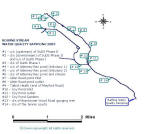|
 Coy
Pond Gardens Water
Quality Data 2003 Coy
Pond Gardens Water
Quality Data 2003
We
regularly sample water quality Monkton
Crescent in Alderney, where the
stream is culverted; it then reappears some 2.5km further downstream at Coy Pond Gardens.
The Coy
Pond Gardens sampling site is slightly upstream of the stepped entrance
to the gardens opposite Coy Pond and downstream of the small SUDS ponds
created in November 2003.
It's clear from the
charts below that water discharging from the culvert at Coy Pond
Gardens has deteriorated somewhat during its time in the
underground sewer system.
The 2003 stream
improvements, and newly created ponds, were constructed to treat the
water as it exits the culvert.
The table below shows a very high
presence of coliforms measured at Coy Pond Gardens during 2003:
Results are compared with Bathing Water
standards (shown left) for comparison purposes only
|
European Bathing Water Directive
|
Coy
Pond Gardens
|
|
Imperative (minimum) standard
per
100ml of water
|
2003 average
coliforms
per
100ml water
|
|
10,000 total coliforms
2,000 faecal coliforms
n/a
|
1,073,477 total coliforms
7,841 faecal coliforms
964 faecal streptococci
|
However, the
very high averages were affected greatly by the heavy rainfall of
28th August following a 27-day dry period [more].
The differences between the two charts
(above and below)
indicate how 'first flush'
events can drastically effect stream water quality, and why it's important
that we hold and treat such water wherever and whenever we can.
Taking 28th August out
of the equation:
|
European Bathing Water Directive
|
Coy Pond Gardens
|
|
Imperative (minimum)
standard
per 100ml water
|
2003 average, excl. 28 Aug
per 100ml water
|
|
10,000 total coliforms
2,000 faecal coliforms
n/a
|
7,297 total coliforms
1,259 faecal coliforms
319 faecal streptococci
|
Results are compared with Bathing Water
standards (left) for comparison purposes only
|